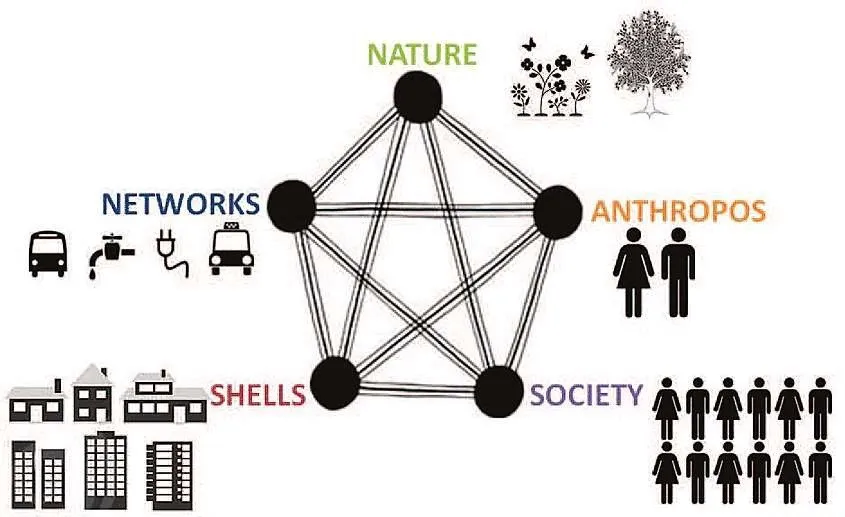If you want to know about the radburn theory or satellite town planning concept or town planning principles in ancient India please click the link.
Ekistics is a term used to describe the study of human settlements, including their planning, design, and management. The development theory of ekistics is based on the idea that the physical, social, and economic aspects of human settlements are interconnected and must be considered as a whole in order to create sustainable and livable communities.
This theory emphasizes the importance of balancing the needs of individuals and communities with the preservation of natural resources and the environment. It also stresses the importance of involving local populations in the decision-making process for development projects.
1) Ekistics development

- Ekistics, the Science of Human Settlements “Ekistics starts with the premise that human settlements are susceptible of systematic investigation”- Constantinos A. Doxiadis.
- In order to create the cities of the future, we need to systematically develop a science of human settlements.
- This science, termed Ekistics, will take into consideration the principles man takes into account when building his settlements, as well as the evolution of human settlements through history in terms of size and quality.
- The target is to build the city of optimum size, that is a city which respects human dimensions. Since there is no point in resisting development, we should try to accommodate technological evolution and the needs of man within the same settlement.
- Ekistics, study of human settlement, which examines not only built forms, but also the interface of time, movements and systems in the built environment.
- Doxiadis saw ekistics as an intellectual approach to balance the convergence of the past, present, and future in human settlements as well as a system for creativity coping with the growth of population, rapid change with the growth of population, rapid change and the pressures of large-scale, high-density housing.
- The whole range of human settlements, is a very complex system of five elements- man, nature, society, shells and networks.
- It is a system of natural, social and artificial elements which can be seen in many ways-economic, social, political, technological and cultural.
2) Ekistics … Nature & Goals of Settlement
Five elements forms a system. Goal- make man happy and safe.

Ekistics is the study of human settlements, including their planning, design, and management. It aims to understand the physical, social, and economic aspects of settlements and how they interact with each other and with the environment.
The nature of settlements is holistic, meaning that all aspects are interconnected and must be considered together in order to create livable, sustainable communities.
The goals of ekistics are to create settlements that are efficient, livable, and sustainable. This involves balancing the needs of individuals and communities with the preservation of natural resources and the environment.
Ekistics also seeks to promote the well-being of all residents, recognizing that human settlements should be designed and managed in a way that meets the needs of all members of the community, including the most vulnerable.
3) Ekistics units
In ekistics, a settlement is divided into smaller units called ekistic units. These units are used to study and understand the different components that make up a settlement, including physical, social, and economic elements.


4) Ekistics

- Ekistics Logarithmic Scale (ELS)
- ELS consists of 15 Ekistic Units ranging from Man to Ecumenopolis
- Classified under 4 major types
- Minor shells, or elementary units (man, room, house)
- Micro-settlements, the units smaller than, or as small as, the traditional town where people used to and still do achieve interconnection by walking.
- Meso-settlements, between the traditional town and the conurbation within which one can commute daily
- Macro-settlements, whose largest possible expression is the Ecumenopolis (city made of the wholw world).
5) Principle of ekistics developments
i) Ekistics … First Principle
Maximization of human’s potential
- Contacts with the elements of nature (such as water and trees), with other people, and with the works of man (such as buildings and roads).
- This, after all, amounts to an operational definition of personal human freedom.
- This is in accordance with this principle that man abandoned the Garden of Eden and is today attempting to conquer the cosmos.
- It is because of this principle that man considers himself imprisoned, even if given the best type of environment, if he is surrounded by a wall without doors.
- In this, man differs from animals: we do not know of any species of animals that try to increase their potential contacts with the environment once they have reached the optimum number of contacts. Man alone always seeks to increase his contacts.
ii) Ekistics … Second Principle
Minimization of the effort
- Minimization of the effort required for the achievement of man’s actual and potential contacts.
- He always gives his structures the shape, or selects the route, that requires the minimum effort, no matter whether he is dealing with the floor of a room, which he tends to make horizontal, or with the creation of a highway.
iii) Ekistics … Third Principle
Optimization of man’s protective space
- Optimization of man’s protective space, which means the selection of such a distance from other persons, animals, objects that he can keep his contacts with them (first principle) without any kind of sensory or psychological discomfort.
- This has to be true at every moment and in every locality, whether it is temporary or permanent and whether man is alone or part of a group.
- This has been demonstrated very well, lately, for the single individual, by anthropologists such as E. T. Hall and psychiatrists such as Augustus F. Kinzel, and by the clothes man designs for himself, and it may be explained not only as a psychological but also as a physiological problem if we think of the layers of air that surround us or the energy that we represent. The walls of houses or fortification walls around cities are other expressions of this third principle.
iv) Ekistics … Fourth Principle
Optimization of the quality of man’s relationship with his environment
- Optimization of the quality of man’s relationship with his environment, which consists of nature, Anthropos, society, shells, and networks.

- This is the principle that leads to order, physiological and aesthetic, and that influences architecture and, in many respects, arts.
v) Ekistics … Fifth Principle
Man organizes his settlements in an attempt to achieve an optimum synthesis of the other four principles
- Man organizes his settlements in an attempt to achieve an optimum synthesis of the other four principles, and this optimization is dependent on time and Space, on actual conditions, and on man’s ability create a synthesis.
- When he has achieved this by creating a system of floor’s walls, roofs, doors and windows which allows him to maximize his potential contacts (first principle) while minimizing the energy expended (second principle) and at the same time makes possible his separation from others (third principle) and the desirable relationship with his environment (fourth principle), we speak of “successful human settlements”.
- What we mean is settlements that have achieved a balance between man and his man-made environment, by complying with all five principles.
Finally, ekistics development theory places a strong emphasis on the importance of participation and collaboration in the development process. It recognizes that the people who live in a community have a wealth of knowledge and experience that should be taken into account when planning and designing settlements. This means involving local residents in the decision-making process, and considering their needs and perspectives in the development of their communities.